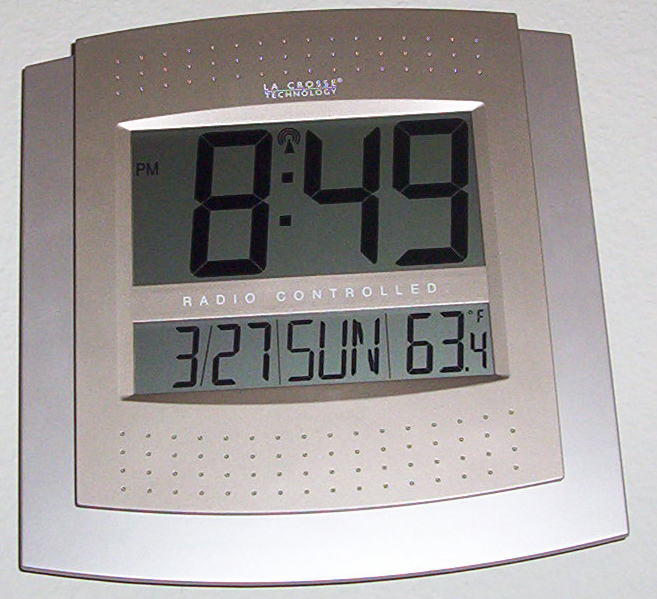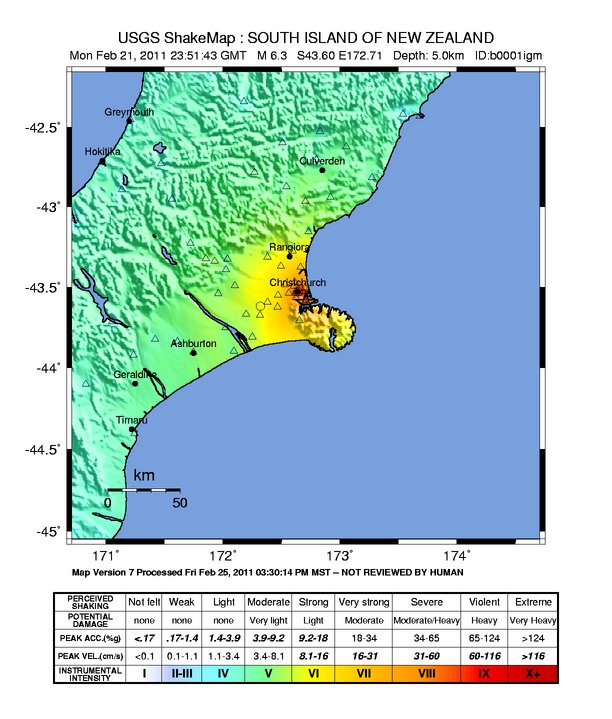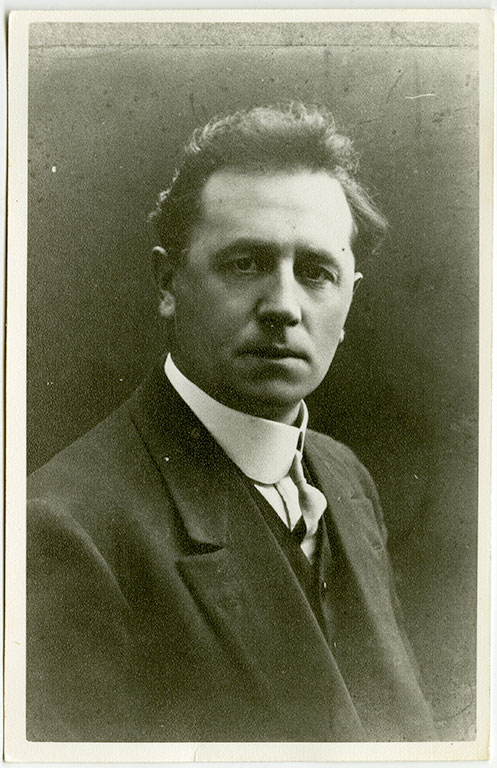|
2016 Christchurch Earthquake
An earthquake occurred in Christchurch on 14 February 2016 at 1:13 p.m. local time (00:13 UTC) and initially recorded as 5.9 on the Richter scale, but subsequently reviewed as 5.7. Often referred to as the Valentine's Day earthquake, it was centred in the sea off New Brighton at a depth of . It was the first large earthquake that the Christchurch area had experienced since May 2012, and it was part of the earthquake sequence that started with the 4 September 2010 Canterbury earthquake. A number of cliffs collapsed at Scarborough ( Godley Head and Whitewash Head), Richmond Hill, and Sumner (Peacock's Gallop). The shipping containers that were still placed along Peacock's Gallop on Main Road stopped falling rocks from hitting passing cyclists. Two surfers were below Whitewash Head and had car-size rocks crash into the sea around them. Impact Westfield Riccarton, Eastgate Mall, The Palms, and Ballantynes were evacuated and closed for engineering inspection. There was co ... [...More Info...] [...Related Items...] OR: [Wikipedia] [Google] [Baidu] |
Time In New Zealand
Time in New Zealand is divided by law into two standard time, standard time zones. The main islands use New Zealand Standard Time (NZST), 12 hours in advance of Coordinated Universal Time (UTC) / Military time zone, military M (Mike), while the outlying Chatham Islands use Chatham Standard Time Zone, Chatham Standard Time (CHAST), 12 hours 45 minutes in advance of UTC / military M^ (Mike-Three). During summer months – from the last Sunday in September until the first Sunday in April – daylight saving time is observed and clocks are advanced one hour. New Zealand Daylight Time (NZDT) is 13 hours ahead of UTC, and Chatham Daylight Time (CHADT) 13 hours 45 minutes ahead. New Zealand's associated states – the Cook Islands and Niue – and the dependent territory of Tokelau use several different time zones at their own discretion. History On 2 November 1868, New Zealand officially adopted a standard time to be observed nationally, and was the first country to do so, abou ... [...More Info...] [...Related Items...] OR: [Wikipedia] [Google] [Baidu] |
Westfield Riccarton
Westfield Riccarton, also known by its former name Riccarton Mall, is a large retail complex located in the Christchurch, New Zealand, suburb of Riccarton. First opened on 3 November 1965, it is Christchurch's oldest shopping mall. The complex is currently anchored by Farmers, Kmart, H&M, Pak'nSave, Rebel Sport, Chemist Warehouse Group, JB Hi-Fi and Hoyts. History Early history Construction of Riccarton Mall began in February 1965. It was officially opened by John McAlpine, MP for Selwyn and Minister of Transport, on 2 November 1965 and opened to shoppers the following day. The initial mall covered and cost £525,000 to construct ($22.6 million in December 2021 dollars). It contained 20 retailers including three anchor tenants: The Farmers' supermarket and department store (owned by the New Zealand Farmers' Co-operative Association of Canterbury), a Four Square-New World supermarket, and a McKenzie's department store. A extension to the mall opened in November 1970 a ... [...More Info...] [...Related Items...] OR: [Wikipedia] [Google] [Baidu] |
Wellington
Wellington is the capital city of New Zealand. It is located at the south-western tip of the North Island, between Cook Strait and the Remutaka Range. Wellington is the third-largest city in New Zealand (second largest in the North Island), and is the administrative centre of the Wellington Region. It is the world's southernmost capital of a sovereign state. Wellington features a temperate maritime climate, and is the world's windiest city by average wind speed. Māori oral tradition tells that Kupe discovered and explored the region in about the 10th century. The area was initially settled by Māori iwi such as Rangitāne and Muaūpoko. The disruptions of the Musket Wars led to them being overwhelmed by northern iwi such as Te Āti Awa by the early 19th century. Wellington's current form was originally designed by Captain William Mein Smith, the first Surveyor General for Edward Wakefield's New Zealand Company, in 1840. Smith's plan included a series of inter ... [...More Info...] [...Related Items...] OR: [Wikipedia] [Google] [Baidu] |
National Crisis Management Centre
The National Crisis Management Centre (NCMC), also known as the Beehive Bunker, is the New Zealand government crisis management command centre situated under the "Beehive" building in Wellington. The centre is designed to be self-sufficient in the event of a disaster. It is designed to withstand earthquakes rated 'Intense' (X) on the Modified Mercalli scale, and is maintained by the National Emergency Management Agency to be always ready for an emergency. It has emergency electricity, water and food supplies; security systems, etc. It also has sleeping accommodation, first aid facilities and a cafeteria with a feeding capacity of 100 people. History The National Crisis Management Centre opened in 1972. An Alternative National Crisis Management Centre was established in Auckland following the 2016 Kaikōura earthquake. It is intended to be activated if the facility in Wellington was damaged, in the event of a wide-spread emergency or if the national government has been for ... [...More Info...] [...Related Items...] OR: [Wikipedia] [Google] [Baidu] |
Christchurch Central City
Christchurch Central City or Christchurch City Centre is the geographical centre and the heart of Christchurch, New Zealand. It is defined as the area within the Four Avenues (Bealey Avenue, Fitzgerald Avenue, Moorhouse Avenue and Deans Avenue) and thus includes the densely built up central city, some less dense surrounding areas of residential, educational and industrial usage, and green space including Hagley Park, Christchurch, Hagley Park, the Christchurch Botanic Gardens and the Barbadoes Street Cemetery. It suffered heavy damage in the September 2010 Canterbury earthquake and was devastated five months later, in the February 2011 Christchurch earthquake. Following this second earthquake, the Central City Red Zone was set up and, with a gradually shrinking area, remained inaccessible except to authorised contractors until June 2013. However, proposals to relocate the city centre elsewhere, to avoid future damage, were considered both uneconomical (as much of the infrastr ... [...More Info...] [...Related Items...] OR: [Wikipedia] [Google] [Baidu] |
2011 Christchurch Earthquake
A major earthquake occurred in Christchurch on Tuesday 22 February 2011 at 12:51 p.m. New Zealand Daylight Time, local time (23:51 Coordinated Universal Time, UTC, 21 February). The () earthquake struck the Canterbury Region in the South Island, centred south-east of the central business district. It caused widespread damage across Christchurch, killing 185 people in List of disasters in New Zealand by death toll, New Zealand's fifth-deadliest disaster. Scientists classified it as an intraplate earthquake and a potential aftershock of the 2010 Canterbury earthquake, September 2010 Canterbury earthquake. Christchurch's central city and eastern suburbs were badly affected, with damage to buildings and infrastructure already weakened by the 2010 Canterbury earthquake and its aftershocks. Significant soil liquefaction, liquefaction affected the eastern suburbs, producing around 400,000 tonnes of silt. The earthquake was felt across the South Island and parts of ... [...More Info...] [...Related Items...] OR: [Wikipedia] [Google] [Baidu] |
Centre Of Contemporary Art
Centre of Contemporary Art (CoCA, formerly the Canterbury Society of Arts) is a curated art gallery in the centre of Christchurch, New Zealand. The gallery is governed by the Canterbury Society of Arts Charitable Trust. History The Canterbury Society of Arts CoCA began in 1880 as the Canterbury Society of Arts (CSA). It was the first organisation to exhibit and collect artworks in Christchurch, and quickly became the most influential and dynamic arts society in New Zealand. Its first exhibition was held in 1881 at Christchurch Boys' High School, in what later became part of the Christchurch Arts Centre. The CSA played an essential role in New Zealand's burgeoning arts scene. In the 1930s it exhibited the works of “ The Group”; a collection of artists including the eminent New Zealand painters Rita Angus, Evelyn Page and Doris Lusk. The CSA found its first permanent home in 1890 in a building especially designed for it by society member and acclaimed New Zealand ar ... [...More Info...] [...Related Items...] OR: [Wikipedia] [Google] [Baidu] |
Parklands, New Zealand
Parklands is a suburb of Christchurch, New Zealand. It is located north east of the city centre near Bottle Lake Forest. The area between Burwood Hospital and Waimairi Golf Club was occupied by a brickworks established by John Brightling (1842–1928). It was developed as a residential suburb from 1963. Demographics Parklands, comprising the statistical areas of Parklands, Waitikiri and Queenspark, covers . It had an estimated population of as of with a population density of people per km2. Before the 2023 census, the suburb had a smaller boundary, covering . Using that boundary, Parklands had a population of 10,242 at the 2018 New Zealand census, an increase of 441 people (4.5%) since the 2013 census, and an increase of 1,194 people (13.2%) since the 2006 census. There were 3,645 households, comprising 5,058 males and 5,184 females, giving a sex ratio of 0.98 males per female, with 2,238 people (21.9%) aged under 15 years, 1,827 (17.8%) aged 15 to 29, 4,854 (47.4% ... [...More Info...] [...Related Items...] OR: [Wikipedia] [Google] [Baidu] |
Bexley, New Zealand
Bexley is an eastern suburb of Christchurch, New Zealand. It is located on the right bank of the Avon River / Ōtākaro approximately one kilometre from the Avon Heathcote Estuary. It is enclosed within a bend in the Avon River / Ōtākaro and borders the suburb of Aranui. Geography Bexley is one of the eastern suburbs. Its eastern boundary is the Avon River. Boundary roads are Pages Road in the north, Shuttle Drive in the west, and Cuthberts Road, Breezes Road and Bridge Street in the south. Bexley was substantially damaged in the February 2011 earthquake, with approximately 90% of homes in the area needing to be demolished, mostly due to the effects of liquefaction, and placed in a residential red zone. Much of the suburb is now recreational open space. Aranui is located to the north of Pages Road. Earthquake damage In the earthquake of September 2010 over 100 houses in the suburb were rendered uninhabitable by silt and subsidence due to soil liquefaction. Flooding from ... [...More Info...] [...Related Items...] OR: [Wikipedia] [Google] [Baidu] |
New Regent Street
New Regent Street is a pedestrian mall in Christchurch. Built as a private development in the early 1930s with 40 shops in Mission Revival architecture, Spanish Mission architectural style, it is one of the city's major tourist attractions. Providing a number of small shops as a comprehensive development was an advanced idea at the time, and New Regent Street is regarded as a forerunner to modern shopping malls. Due to its coherent architectural character, the buildings in the streets are listed as Category I heritage items by Heritage New Zealand, and in addition, the entire street has a historic area listing. The street was pedestrianised in 1994 in preparation for the introduction of the Christchurch tramway system#Modern era: 1995–present, Christchurch heritage tram, which began operation in February 1995. Damaged in the February 2011 Christchurch earthquake, the street and buildings reopened in April 2013, and the tram returned from November of that year. Following the 2016 ... [...More Info...] [...Related Items...] OR: [Wikipedia] [Google] [Baidu] |
Northlands Shopping Centre
Northlands Shopping Centre, in Christchurch, New Zealand, is the South Island's second-largest mall. Founded in 1967, it is owned by Mackersy Northlands Limited Partnership. It is located in the Christchurch suburb of Papanui. The shopping centre is single-level building, with over 110 tenants, including shops, bars, cafés and restaurants. It also has a multistorey car park. The main occupants of the shopping centre are Farmers Trading Company, Farmers department store, The Warehouse Group, The Warehouse retail store, Hoyts, Hoyts cinema, Pak'nSave, Pak'nSave supermarket (until 2024), and Woolworths (New Zealand supermarket chain), Woolworths. The mall was extended with addition of food court, "winter garden" style dining conservatory, and outdoor seating area. History Plans for the shopping centre were announced in July 1966. The first stage would be the construction of a Hay's department store and supermarket, with the second stage being the construction of the mall with a ... [...More Info...] [...Related Items...] OR: [Wikipedia] [Google] [Baidu] |





